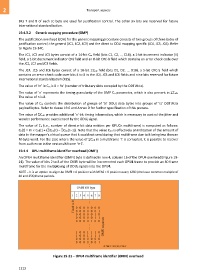Page 1222 - 5G Basics - Core Network Aspects
P. 1222
2 Transport aspects
Bits 7 and 8 of each JC byte are used for justification control. The other six bits are reserved for future
international standardization.
19.4.3.2 Generic mapping procedure (GMP)
The justification overhead (JOH) for the generic mapping procedure consists of two groups of three bytes of
justification control; the general (JC1, JC2, JC3) and the client to ODU mapping specific (JC4, JC5, JC6). Refer
to Figure 19-14C.
The JC1, JC2 and JC3 bytes consist of a 14-bit Cm field (bits C1, C2, .., C14), a 1-bit increment indicator (II)
field, a 1-bit decrement indicator (DI) field and an 8-bit CRC-8 field which contains an error check code over
the JC1, JC2 and JC3 fields.
The JC4, JC5 and JC6 bytes consist of a 10-bit CnD field (bits D1, D2, .., D10), a 5-bit CRC-5 field which
contains an error check code over bits 4 to 8 in the JC4, JC5 and JC6 fields and nine bits reserved for future
international standardization (RES).
The value of 'm' in Cm is 8 'ts' (number of tributary slots occupied by the ODTUk.ts).
The value of 'n' represents the timing granularity of the GMP Cn parameter, which is also present in CnD.
The value of n is 8.
The value of Cm controls the distribution of groups of 'ts' ODUj data bytes into groups of 'ts' ODTUk.ts
payload bytes. Refer to clause 19.6 and Annex D for further specification of this process.
The value of CnD provides additional 'n'-bit timing information, which is necessary to control the jitter and
wander performance experienced by the ODUj signal.
The value of Cn (i.e., number of client n-bit data entities per OPUCn multiframe) is computed as follows:
Cn(t) = m Cm(t) + (CnD(t) – CnD(t–1)). Note that the value CnD is effectively an indication of the amount of
data in the mapper's virtual queue that it could not send during that multiframe due to it being less than an
M-byte word. For the case where the value of CnD in a multiframe 't' is corrupted, it is possible to recover
from such error in the next multiframe 't+1'.
19.4.4 OPU multiframe identifier overhead (OMFI)
An OPU4 multiframe identifier (OMFI) byte is defined in row 4, column 16 of the OPU4 overhead (Figure 19-
21). The value of bits 2 to 8 of the OMFI byte will be incremented each OPU4 frame to provide an 80 frame
multiframe for the multiplexing of ODUj signals into the OPU4.
NOTE – It is an option to align the OMFI = 0 position with MFAS = 0 position every 1280 (the least common multiple of
80 and 256) frame periods.
Figure 19-21 OPU4 multiframe identifier (OMFI) overhead
1212

